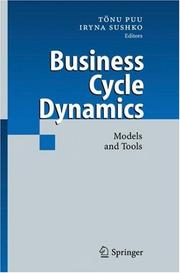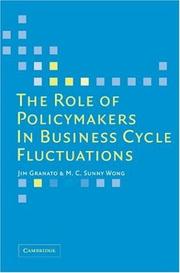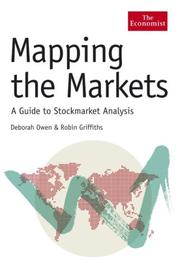| Listing 1 - 10 of 69 | << page >> |
Sort by
|

ISBN: 1280615192 9786610615193 3540321683 3540321675 Year: 2006 Publisher: Berlin ; New York : Springer,
Abstract | Keywords | Export | Availability | Bookmark
 Loading...
Loading...Choose an application
- Reference Manager
- EndNote
- RefWorks (Direct export to RefWorks)
Business cycle theory has been one of the fastest growing fields in modern nonlinear economic dynamics. The book is centered around models of multiplier-accelerator type, emerging from Samuelson's seminal work, later developed into nonlinear formats by Hicks and Goodwin. These models left open ends, as the tools then available did not permit more systematic analysis. The present situation is different, due to the emergence of new methods also focusing global analysis. The focus on classical, causal or recursive models implies a deviation from current main stream business cycle theory, based on "rational expectations", which in view of the possibility of mathematical chaos becomes untenable. This book is a rejoinder to Puu and Sushko, Oligopoly Dynamics - Models and Tools, (Springer 2002).
Business cycles --- Economics --- Mathematical models --- Economic cycles --- Economic fluctuations --- Cycles
Book
ISBN: 1451863098 146239017X 1451908458 9786613821218 1452798583 1282448021 Year: 2006 Publisher: Washington, D.C. : International Monetary Fund,
Abstract | Keywords | Export | Availability | Bookmark
 Loading...
Loading...Choose an application
- Reference Manager
- EndNote
- RefWorks (Direct export to RefWorks)
This paper constructs new business cycle indices for Argentina, Brazil, Chile, and Mexico based on common dynamic factors extracted from a comprehensive set of sectoral output, external data, and fiscal and financial variables spanning over a century. The constructed indices are used to derive a business cycle chronology for these countries and characterize a set of new stylized facts. In particular, we show that all four countries have historically displayed a striking combination of high business cycle and persistence relative to benchmark countries, and that such volatility has been time-varying, with important differences across policy regimes. We also uncover a sizeable common factor across the four economies which has greatly limited scope for regional risk sharing.
Business cycles -- Latin America -- Econometric models. --- Business forescasting -- Latin America. --- Electronic books. -- local. --- Business & Economics --- Economic Theory --- Business cycles --- Business forescasting --- Econometric models. --- Economic cycles --- Economic fluctuations --- Business forecasting --- Cycles --- Business --- Business forecasts --- Forecasting, Business --- Economic forecasting --- Forecasting --- Econometrics --- Exports and Imports --- Macroeconomics --- Public Finance --- Business Fluctuations --- Economic History: Macroeconomics and Monetary Economics --- Growth and Fluctuations: General, International, or Comparative --- Prices, Business Fluctuations, and Cycles: General (includes Measurement and Data) --- Classification Methods --- Cluster Analysis --- Principal Components --- Factor Models --- Empirical Studies of Trade --- National Government Expenditures and Related Policies: General --- Economic growth --- Econometrics & economic statistics --- International economics --- Public finance & taxation --- Factor models --- Terms of trade --- Economic recession --- Expenditure --- Econometric analysis --- International trade --- Econometric models --- Economic policy --- nternational cooperation --- Recessions --- Expenditures, Public --- Mexico

ISBN: 9780511510540 9780521860161 9780521390767 0511169280 9780511169281 0511510543 0521860164 0521390761 1107156432 1280449233 0511168853 051116789X 0511312547 0511168411 Year: 2006 Publisher: Cambridge : Cambridge University Press,
Abstract | Keywords | Export | Availability | Bookmark
 Loading...
Loading...Choose an application
- Reference Manager
- EndNote
- RefWorks (Direct export to RefWorks)
This book's central theme is that a policymaker's role is to enhance the public's ability to coordinate their price information, price expectations, and economic activities. This role is fulfilled when policymakers maintain inflation stability. Inflation persists less when an implicit or explicit inflation target is met. Granato and Wong argue that inflation persistence is reduced when the public substitutes the prespecified inflation target for past inflation. A by-product of this co-ordination process is greater economic stability. In particular, inflation stability contributes to greater economic output stability, including the potential for the simultaneous reduction of both inflation and output variability - inflation-output co-stabilization (IOCS). Granato and Wong use historical, formal, and applied statistical analysis of business-cycle performance in the United States for the 1960 to 2000 period. They find that during periods when policymakers emphasize inflation stability, inflation uncertainty and persistence were reduced.
Economic policy. --- Business cycles. --- Inflation (Finance) --- Finance --- Natural rate of unemployment --- Economic cycles --- Economic fluctuations --- Cycles --- Economic nationalism --- Economic planning --- National planning --- State planning --- Economics --- Planning --- National security --- Social policy --- Social Sciences --- Political Science
Book
ISBN: 1451864604 1462367968 145199219X 9786613822536 1452787476 1282586599 Year: 2006 Publisher: Washington, D.C. : International Monetary Fund,
Abstract | Keywords | Export | Availability | Bookmark
 Loading...
Loading...Choose an application
- Reference Manager
- EndNote
- RefWorks (Direct export to RefWorks)
This paper argues that limited asset market participation is crucial in explaining U.S. macroeconomic performance and monetary policy before the 1980s, and their changes thereafter. We develop an otherwise standard sticky-price dynamic stochastic general equilibrium model, which implies that at low asset-market participation rates, the interest rate elasticity of output (the slope of the IS curve) becomes positive - that is, "non-Keynesian." Remarkably, in that case, a passive monetary policy rule ensures equilibrium determinacy and maximizes welfare. Consequently, we argue that the policy of the Federal Reserve System in the pre-Volcker era, often associated with a passive monetary policy rule, was closer to optimal than conventional wisdom suggests and may thus have remained unchanged at a fundamental level thereafter. We provide institutional and empirical evidence for our hypothesis, in the latter case using Bayesian estimation techniques, and show that our model is able to explain most features of the "Great Inflation.".
Electronic books. -- local. --- Inflation (Finance). --- Monetary policy. --- Finance --- Business & Economics --- Money --- Inflation (Finance) --- Monetary management --- Economic policy --- Currency boards --- Money supply --- Natural rate of unemployment --- Banks and Banking --- Finance: General --- Inflation --- Macroeconomics --- Price Level --- Deflation --- Business Fluctuations --- Cycles --- Financial Markets and the Macroeconomy --- Monetary Policy --- Central Banks and Their Policies --- Studies of Particular Policy Episodes --- Economic History: Macroeconomics --- Growth and Fluctuations: U.S. --- Canada: 1913 --- -Economic History: Financial Markets and Institutions: U.S. --- General Financial Markets: General (includes Measurement and Data) --- Macroeconomics: Consumption --- Saving --- Wealth --- Interest Rates: Determination, Term Structure, and Effects --- Securities markets --- Consumption --- Hyperinflation --- Real interest rates --- Financial markets --- Prices --- National accounts --- Financial services --- Capital market --- Economics --- Interest rates --- United States
Book
ISBN: 1451865473 1462390153 1451910002 9786613828514 1451990359 1283516063 Year: 2006 Publisher: Washington, D.C. : International Monetary Fund,
Abstract | Keywords | Export | Availability | Bookmark
 Loading...
Loading...Choose an application
- Reference Manager
- EndNote
- RefWorks (Direct export to RefWorks)
This paper compares the pattern of macroeconomic volatility in 17 Latin American countries during episodes of high and low growth since 1970, examining in particular the role of policy volatility. Macroeconomic outcomes are distinguished from macroeconomic policies, structural reforms and reversals, shocks, and institutional constraints. Based on previous work, a composite measure of structural reforms is constructed for the 1970-2004 period. We find that outcomes and policies are more volatile in low growth episodes, while shocks (except U.S. interest rates) are similar across episodes. Fiscal policy volatility is associated with lower growth, but fiscal policy procyclicality is not. Low levels of market-oriented reforms and structural reform reversals are also associated with lower growth.
Business cycles --- Latin America --- Economic policy. --- Economic conditions. --- Economic cycles --- Economic fluctuations --- Cycles --- Banks and Banking --- Foreign Exchange --- Macroeconomics --- Public Finance --- Econometric and Statistical Methods: Special Topics: General --- Comparative or Joint Analysis of Fiscal and Monetary Policy --- Stabilization --- Treasury Policy --- Economic History: Macroeconomics --- Growth and Fluctuations: Latin America --- Caribbean --- Institutions and the Macroeconomy --- Fiscal Policy --- Interest Rates: Determination, Term Structure, and Effects --- Currency --- Foreign exchange --- Finance --- Economic & financial crises & disasters --- Structural reforms --- Exchange rate arrangements --- Fiscal policy --- Real interest rates --- Currency crises --- Macrostructural analysis --- Financial services --- Financial crises --- Interest rates --- Venezuela, República Bolivariana de
Book
ISBN: 1462324592 1283515903 9786613828354 1451908482 Year: 2006 Volume: WP/06/52 Publisher: Washington, D.C. : International Monetary Fund,
Abstract | Keywords | Export | Availability | Bookmark
 Loading...
Loading...Choose an application
- Reference Manager
- EndNote
- RefWorks (Direct export to RefWorks)
Workers' remittances are often argued to have a tendency to move countercyclically with the GDP in recipient countries since migrant workers are expected to remit more during down cycles of economic activity back home. Yet, how much to remit is a complex decision involving other factors, and different variables driving remittance behavior are differently affected by the state of economic activity over the business cycle. This paper investigates the behavior of workers' remittances flows into 12 developing countries over their respective business cycles during 1976-2003 and finds that countercyclicality of receipts is not commonly observed across these countries.
Emigrant remittances. --- Immigrant remittances --- Remittances, Emigrant --- Foreign exchange --- Exports and Imports --- Finance: General --- Labor --- Macroeconomics --- Business Fluctuations --- Cycles --- International Migration --- Macroeconomic Aspects of International Trade and Finance: Other --- Geographic Labor Mobility --- Immigrant Workers --- International Factor Movements and International Business: General --- Remittances --- Labor Force and Employment, Size, and Structure --- Prices, Business Fluctuations, and Cycles: General (includes Measurement and Data) --- Aggregate Factor Income Distribution --- General Financial Markets: Government Policy and Regulation --- International economics --- Labour --- income economics --- Economic growth --- Finance --- Migrant labor --- Business cycles --- Income --- Procyclicality --- Balance of payments --- National accounts --- Financial sector policy and analysis --- International finance --- Financial risk management --- Lesotho, Kingdom of

ISBN: 9780195301069 0195301064 9780199828234 Year: 2006 Publisher: Oxford, UK ; New York, NY : Oxford University Press,
Abstract | Keywords | Export | Availability | Bookmark
 Loading...
Loading...Choose an application
- Reference Manager
- EndNote
- RefWorks (Direct export to RefWorks)
Physiology of nerves and sense organs --- Psychology --- Brain --- Cortical Synchronization. --- Periodicity. --- Oscillations. --- Biological rhythms. --- Cerveau --- Oscillations --- Rythmes biologiques --- physiology. --- Physiology. --- Physiologie --- Medische psychologie --- neuropsychologie --- neuropsychologie. --- Biological rhythms --- Cycles --- Fluctuations (Physics) --- Vibration --- Biological clocks --- Biology --- Biorhythms --- Endogenous rhythms --- Living clocks --- Rhythms, Biological --- Chronobiology --- Pacemaker cells --- Physiology --- Periodicity --- Rythmes biologiques. --- Physiologie. --- physiology
Periodical
ISSN: 18153828 Year: 2006 Publisher: Katlenberg-Lindau, Germany : Published by Copernicus on behalf of the European Geosciences Union
Abstract | Keywords | Export | Availability | Bookmark
 Loading...
Loading...Choose an application
- Reference Manager
- EndNote
- RefWorks (Direct export to RefWorks)
Earth sciences --- Climatic changes --- Climatic changes. --- Earth sciences. --- Geosciences --- Changes, Climatic --- Climate change --- Climate changes --- Climate variations --- Climatic change --- Climatic fluctuations --- Climatic variations --- Global climate changes --- Global climatic changes --- Environmental aspects --- Climatology --- Climate change mitigation --- Teleconnections (Climatology) --- Environmental sciences --- Physical sciences --- Changes in climate --- Climate change science --- Global environmental change

ISBN: 1576602389 1861979371 9786611031824 1281031828 1847650279 Year: 2006 Publisher: London : Economist Books,
Abstract | Keywords | Export | Availability | Bookmark
 Loading...
Loading...Choose an application
- Reference Manager
- EndNote
- RefWorks (Direct export to RefWorks)
Talks about how to analyse the way markets are likely to behave. This book combines the two approaches used by market analysts: technical analysis, which is based on the belief that price reflects everything; and fundamental analysis, which takes into account all kinds of factors in order to determine the correct price of an asset.
Business cycles. --- Business. --- Investments. --- Stock exchanges. --- Finance --- Business & Economics --- Investment & Speculation --- Stock exchanges --- Business cycles --- Investments --- Investing --- Investment management --- Portfolio --- Economic cycles --- Economic fluctuations --- Bulls and bears --- Commercial corners --- Corners, Commercial --- Equity markets --- Exchanges, Securities --- Exchanges, Stock --- Securities exchanges --- Stock-exchange --- Stock markets --- Disinvestment --- Loans --- Saving and investment --- Speculation --- Cycles --- Capital market --- Efficient market theory
Book
ISBN: 1451865511 1462376029 1451910045 9786613825681 1452736006 1283513234 Year: 2006 Publisher: Washington, D.C. : International Monetary Fund,
Abstract | Keywords | Export | Availability | Bookmark
 Loading...
Loading...Choose an application
- Reference Manager
- EndNote
- RefWorks (Direct export to RefWorks)
This paper uses the standard one-sector neoclassical growth model to investigate why China's consumption has been low and investment high. It finds that the low cost of capital has been quantitatively an important factor. Theory predicts that the price of capital may have been significantly distorted in the 1990s and 2000s. The distortion could have been caused by nonperforming loans, borrowing constraints, and uncertainty over changes in government guidance in bank lending. If China is to rebalance growth towards relying more on consumption and less on exports and investment, banking sector reforms and financial market development could, therefore, turn out to be key.
Business cycles --- Economic development --- Capital market --- Consumption (Economics) --- Investments --- Finance --- Econometric models. --- China --- Economic policy. --- Economic cycles --- Economic fluctuations --- Cycles --- Banks and Banking --- Macroeconomics --- Industries: Financial Services --- Banks --- Depository Institutions --- Micro Finance Institutions --- Mortgages --- Macroeconomics: Consumption --- Saving --- Wealth --- General Aggregative Models: General --- Banking --- Consumption --- Nonperforming loans --- Loans --- National accounts --- Economics --- Banks and banking --- National income --- China, People's Republic of
| Listing 1 - 10 of 69 | << page >> |
Sort by
|

 Search
Search Feedback
Feedback About
About Help
Help News
News